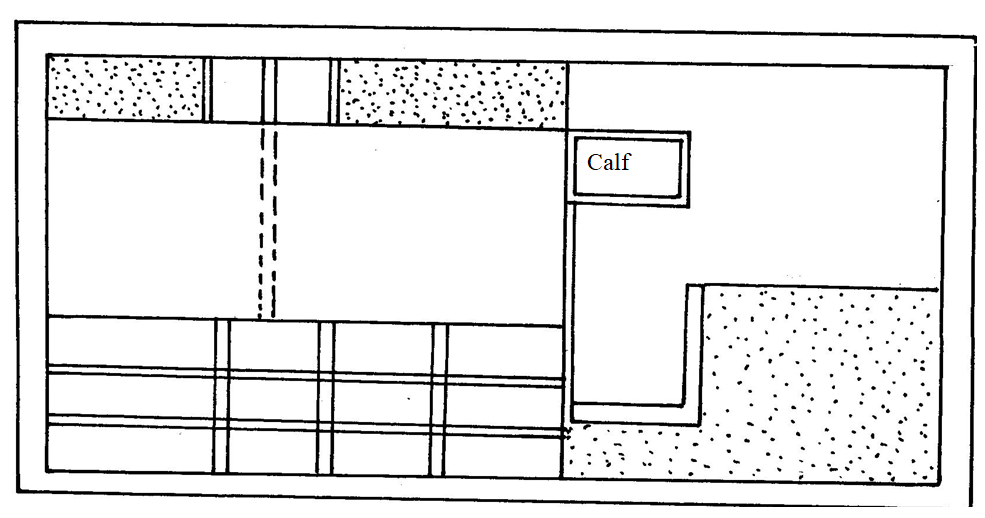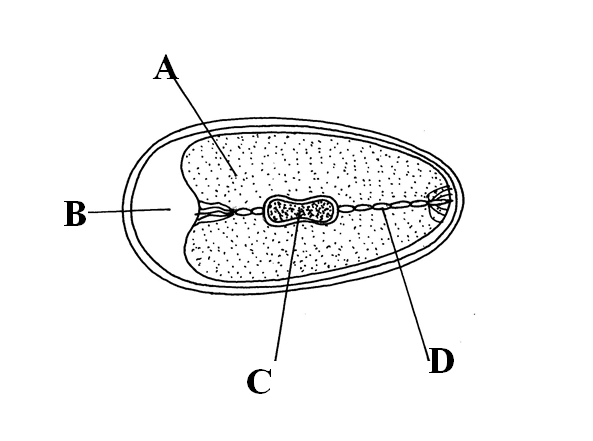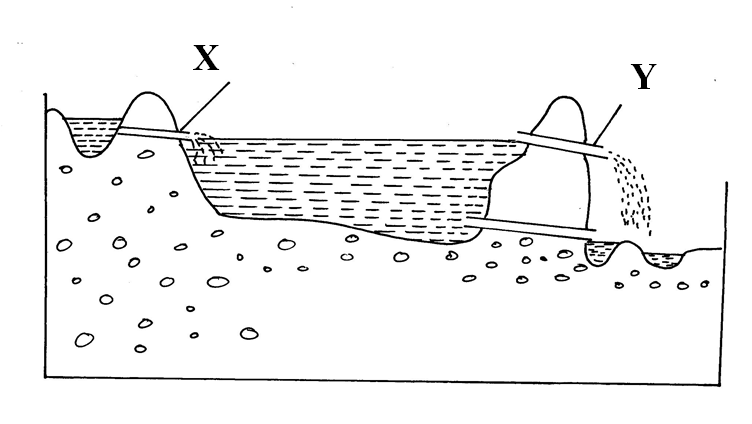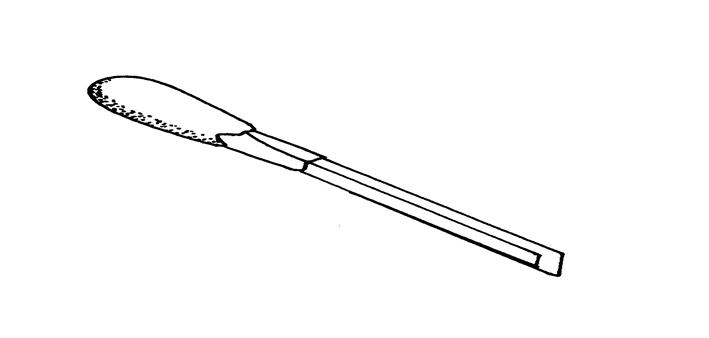State one chemical used in relieving a ruminant animal of bloat
- Epson salt; methyl silicon;
- Mixture of turpentine and vegetable oil
State two reasons why drenching alone is not an effective method of controlling internal parasite in livestock
- Drenching does not destroy particles in pasture, water and forage;
- Drenching does not destroy the intermediate host.
- Drenching does not destroy some/other stage of parasites
State the class of each of the following feedstuff
(i) Molasses
Energy concentrate
(ii) Mac Lick
supplement
Name the type of breeding system represented below

Upgrading/grading up
Give three importance of flushing in sheep management
- Increase conception rate
- Facilitate implantation of the zygote;
- Increase the chances of the multiple births
Name the causative organism of Gumboro disease
Birna virus
State two symptoms of coccidiosis infection in poultry
- Diarrhoea
- Dysentry/blood in the feaces
- Emaciation
- Ruffled feathers
- Dullues with dropping wings
- Sudden death
State two differences between the dromedary and Bactrian breed of camels


State one way by which each of the following practices help in disease control
(a) Proper feeding
- Prevent deciency diseases
- Imparts deficiency to diseases
(b) Proper housing
- prevents draughts;
- prevents dampness due to proper drainage;
- Ease of cleaning;
State three effects of tsetse fly infestation
- Transmits diseases/ Trypanosomiasis
- Suck large quantities of blood/causes anaemia
- Damages skin for hide
- Causes wounds which are routes for secondary infections
- Causes infection/ discomfort to livestock.
State two ways of controlling tsetse flies
- Bush clearing/destroy breeding places
- Spray with chemicals/ Insecticides
- Sterilizing
- Use of fly traps
Give one reason why tsetse fly control is considered as land reclamation method
- Human settlement made possible
- Livestock rearing is made possible
State two ways in which a production ration may be utilized by cattle
- For production of products, milk meat, eggs etc
- For reproduction e.g. foetal development.
- For growth in young stock/animals
- For work/farm power/pulling/draught
Name two diseases in cattle that may be spread through breeding
- Brucellosis/Contagious abortion/bang’s disease
- Trichomoniasis
- Vingivitis
Under what conditions would a farmer prefer to use an ox – cart instead of a tractor – drawn trailer. Give three reasons
- if a farmer has little capital
- if the land is very steep.
- If a farmer has a little load to carry.
Name three implements that may be connected to power take off shaft of a tractor
- Mower
- Planters
- Rotavators
- Sprayers
- Fertilizer spreaders
- Broad casters
Name a pig breed with white colour on feet, nose and tail
Berkeshire
State three importance of keeping livestock healthy
- Increase quantity of livestock products/work output./Regular breeding
- Increase quality of livestock products
- Reduce cost of production
- Prevents spread of diseases
- Increase production of livestock
Name three importance of lubricating system in tractor
- Increase efficiency of the machines
- Reduce heat created by furiction/rubbing surface
- Act as a clearing agent
- Prevent friction/tear and wear.
Name three mechanical methods of controlling ticks
- Burning infested pasture.
- Fencing off the pasture land & farm
- Starting ticks by keeping the animals away from infested pastures land
Name the intermediate host of liver fluke
Mud snail/Fresh water snail
Name three methods of livestock selection
- Mass selection
- Progency testing
- Contemporary comparison
Distinguish between crutching and ringing as used in livestock production
- Crutching; Cutting wool around reproductive organ of ewe/female sheep.
- Ringing; Cutting wool around the sheath
Give a reason for packing eggs with the broadside upwards in the egg tray
For gaseous exchange
State two conditions, which would make it necessary to feed bees
- During drought when there is no flowers
- When a new colony is small and faster reproduction is required.
- When a new colony has first entered the hive and no food resources
Name two faults of ignition system of a tractor
- Sudden stopping
- Continuous engine running
Below is a layout of an animal housing. Study it and answer the questions that follow

(i) Identify the structure
Zero grazing unit
(ii) Name the parts labeled 2, 3, 4
- 2 – cubicles
- 3 – place for cheff cutter/ feed preparation area/ fodder chopping area.
- 4 – milking parlour
(iii) What is the role of the parts labeled 3
cutting livestock feeds
Study the diagram of an egg below and answer the questions that follow

(a) Name the parts labeled A, B, C and D.
A…………………………………………………..
B…………………………………………………
C…………………………………………………
D………………………………………………..
- A – Albumen/Albumin
- B – Air space
- C – Yolk
- D – Charlaza
(b) State the roles of parts labeled A and D during incubation
A……………………………………………………..
D…………………………………………………….
- A – Is a food reserved to the developing click
- D – holds yolk on both ends allowing yolk to move germinal disc always to the top; This encourages heat transfer to the developing embryo.
Drawn below is a diagram of a fish pond

Name the parts labeled X and Y
X……………………………………….
Y……………………………………….
- X – Inlet pipe
- Y – Spill way
State three management practices carried out on a fish pond Y
- Repairing of the dykes
- Clearing/removing foreign materials
- Cutting/clearing vegetation around the pond
- Removing silt.
Below is a diagram of a farm tool

Identify the tool
Wood chisel
State the use of the tool
for carving or cutting a hard material such as wood, stone, or metal by hand, struck with a mallet, or mechanical power
List two maintenance practices carried out on the tool
- Store well after use/tool box/tool rack
- Sharpen the cutting edge/blade
- Coat the blade with oil to prevent rusting
- Repair /replace the handle when damaged
- Enhance Your KCSE Agriculture Exam Preparation with Free KNEC-Based Questions and Marking SchemesReview of Free KNEC KCSE-Based Agriculture Questions with Marking Schemes Looking for a reliable resource to enhance your preparation for the KCSE agriculture exam? Look no further than the free KNEC KCSE-based agriculture questions available for download at swalijibu.co.ke! These papers, coupled with their marking schemes, are an invaluable tool for revision, setting standard exams,… Read more: Enhance Your KCSE Agriculture Exam Preparation with Free KNEC-Based Questions and Marking Schemes
- A365 Examinations Series for Agriculture Paper 2 – 2024 Revision Kit – KCSE Mock Trial Tests for Form 4 LevelGet ready for the Agriculture Paper 2 exam with the A365 Examinations Series. The 2024 Revision Kit provides detailed explanations, practice questions, and mock trial tests to help Form 4 students excel.
- A365 Examinations Series for Agriculture Paper 1, 2024 Revision Kit, and KCSE Mock Trial Tests for Form 4 LevelRead a detailed review of the A365 Examinations Series for Agriculture Paper 1, including the 2024 Revision Kit and KCSE Mock Trial Tests. Discover how this comprehensive online resource can help Form 4 students excel in their exams.
- KCSE 2013 Marking Schemes: Download Free Agriculture Paper 2The marking scheme for Agriculture Paper 2 (443/2) in the KCSE 2013 exam is an essential tool for both students and teachers. It provides a comprehensive guide on how the paper was graded and includes the correct answers along with the corresponding marks allocated for each question. By reviewing the marking scheme, students can gain… Read more: KCSE 2013 Marking Schemes: Download Free Agriculture Paper 2
- KCSE 2013 Marking Schemes: Download Free Agriculture Paper 1The marking scheme for Agriculture Paper 1 (443/1) in the KCSE 2013 exam provides a comprehensive guide on how the paper was graded. It outlines the correct answers and the corresponding marks allocated for each question. The marking scheme ensures consistency and fairness in the evaluation process. It helps examiners assess the knowledge and understanding… Read more: KCSE 2013 Marking Schemes: Download Free Agriculture Paper 1
- Challenges of Platy Soil Structure in Crop ProductionDiscover the reasons why platy soil structure can hinder crop production, including poor drainage, limited aeration, difficult root penetration, and challenges in tillage operations.
- Ways in which good transport and communication systems influence agricultural productionDiscover how good transport and communication systems influence agricultural production by providing access to markets, preventing perishability of goods, and providing market information for farmers.
- The Impact of Liming Soil on Agricultural Productivity: pH Regulation, Nutrient Availability, Microbial Activity, and Soil Structure EnhancementExplore the effects of liming soil in agriculture, including the regulation of pH levels, improved nutrient availability, enhanced microbial activity, and the positive influence on soil structure for optimal plant growth and productivity.
- The Impact of Biotic Factors on Agriculture: Examining the Positive and Negative EffectsExplore the role of biotic factors such as predators and decomposers in agriculture, their positive contributions in pest control and nutrient recycling, as well as their potential negative impacts on crops and soil fertility.
- Characteristics of Plantation Farming: Large Land Tracts, Single Crop Production, Mechanization, and Managerial SkillsDiscover the four key characteristics of plantation farming, including the use of large land tracts, focus on single crop production, high mechanization, and the need for strong managerial skills.
- The Land Title Deed: Unlocking Ownership and RightsIntroduction: The land title deed is a vital document that holds crucial information regarding land ownership and rights. It serves as an official record, providing essential details that establish legal ownership, define property boundaries, and outline the terms and conditions associated with the land. This essay explores the significance of the information commonly found on… Read more: The Land Title Deed: Unlocking Ownership and Rights
- AGRICULTURE REVISION KIT QUESTION PAPER 1 MODEL2492017AGRICULTURE REVISION KIT QUESTION PAPER 1 MODEL2492017 Tell your Besties … Facebook Twitter Linkedin Tumblr Reddit Pinterest Whatsapp Telegram Post Views: 91 Related posts: KCSE PAST PAPERS CHEMISTRY PAPER 1, 2 AND 3 QUESTIONS, ANSWERS-MARKING SCHEMES AND REPORTS KCSE ENGLISH GRAMMAR AND LITERATURE NOTES FORM 4 AGRICULTURE PAPER 1 AND 2 REVISION KITS IN PREPARATIONS… Read more: AGRICULTURE REVISION KIT QUESTION PAPER 1 MODEL2492017
- 443/2 Agriculture Paper 2 form 4 Revision Kit443/2 Agriculture Paper 2 form 4 Revision Kit model29082023002 SECTION A(30MKS) 1. Too much air in silo Causes over heating Causes decomposition (½ x 2= 1mk) 2. Reasons for washing the udder. To stimulate milk let-down To remove dirt. (½ x 2= 1mk) 3. Reason for lubricating. Lower temperature Reduce friction Clean engine parts Increase compression… Read more: 443/2 Agriculture Paper 2 form 4 Revision Kit
- AGRICULTURE PAPER 1 REVISION KIT FOR FORM 4 MODEL29082023001443/1 AGRICULTURE PAPER 1 REVISION KIT FOR FORM 4 MODEL29082023001 SECTION A(30MKS) 1. Contribution to industrial growth. Supply raw materials to industries Provide market to finished industrial goods. Provide capital to set up industries. (½ x 2 = 1mk) 2. Characteristics of intensive farming Land is maximally utilized Permanent labour is maximally used. Yields are… Read more: AGRICULTURE PAPER 1 REVISION KIT FOR FORM 4 MODEL29082023001
- Agriculture Paper 1 – 2022 K.C.S.E Prediction Set 1 MODEL20082023001Agriculture Paper 1 – 2022 K.C.S.E Prediction Set 1 Tell your Besties … Facebook Twitter Linkedin Tumblr Reddit Pinterest Whatsapp Telegram Post Views: 141 Related posts: KCSE PAST PAPERS CHEMISTRY PAPER 1, 2 AND 3 QUESTIONS, ANSWERS-MARKING SCHEMES AND REPORTS KCSE ENGLISH GRAMMAR AND LITERATURE NOTES FORM 4 AGRICULTURE PAPER 1 AND 2 REVISION KITS… Read more: Agriculture Paper 1 – 2022 K.C.S.E Prediction Set 1 MODEL20082023001
- KCSE AGRICULTURE REPLICA SERIES EXAMSKCSE AGRICULTURE REPLICA SERIES EXAMS Tell your Besties … Facebook Twitter Linkedin Tumblr Reddit Pinterest Whatsapp Telegram Post Views: 66 Related posts: KCSE PAST PAPERS CHEMISTRY PAPER 1, 2 AND 3 QUESTIONS, ANSWERS-MARKING SCHEMES AND REPORTS KCSE ENGLISH GRAMMAR AND LITERATURE NOTES FORM 4 AGRICULTURE PAPER 1 AND 2 REVISION KITS IN PREPARATIONS OF KCSE… Read more: KCSE AGRICULTURE REPLICA SERIES EXAMS
- KCSE AGRICULTURE PREDICTION EXAMS MODEL21082023008KCSE AGRICULTURE PREDICTION EXAMS MODEL21082023008 Tell your Besties … Facebook Twitter Linkedin Tumblr Reddit Pinterest Whatsapp Telegram Post Views: 96 Related posts: KCSE PAST PAPERS CHEMISTRY PAPER 1, 2 AND 3 QUESTIONS, ANSWERS-MARKING SCHEMES AND REPORTS KCSE ENGLISH GRAMMAR AND LITERATURE NOTES FORM 4 AGRICULTURE PAPER 1 AND 2 REVISION KITS IN PREPARATIONS OF KCSE… Read more: KCSE AGRICULTURE PREDICTION EXAMS MODEL21082023008
- AGRICULTURE PAPER 1 TOPICAL REVISION QUESTIONSAGRICULTURE PAPER 1 TOPICAL REVISION QUESTIONS Tell your Besties … Facebook Twitter Linkedin Tumblr Reddit Pinterest Whatsapp Telegram Post Views: 84 Related posts: KCSE PAST PAPERS CHEMISTRY PAPER 1, 2 AND 3 QUESTIONS, ANSWERS-MARKING SCHEMES AND REPORTS KCSE ENGLISH GRAMMAR AND LITERATURE NOTES FORM 4 AGRICULTURE PAPER 1 AND 2 REVISION KITS IN PREPARATIONS OF… Read more: AGRICULTURE PAPER 1 TOPICAL REVISION QUESTIONS
- KCSE 2022 AGRICULTURE QUESTION PAPER 1KCSE 2022 AGRICULTURE QUESTION PAPER 1 Tell your Besties … Facebook Twitter Linkedin Tumblr Reddit Pinterest Whatsapp Telegram Post Views: 135 Related posts: KCSE PAST PAPERS CHEMISTRY PAPER 1, 2 AND 3 QUESTIONS, ANSWERS-MARKING SCHEMES AND REPORTS KCSE ENGLISH GRAMMAR AND LITERATURE NOTES FORM 4 AGRICULTURE PAPER 1 AND 2 REVISION KITS IN PREPARATIONS OF… Read more: KCSE 2022 AGRICULTURE QUESTION PAPER 1
- AGRICULTURE FORM 1 SIMPLIFIED NOTESAGRICULTURE FORM 1 SIMPLIFIED NOTES Tell your Besties … Facebook Twitter Linkedin Tumblr Reddit Pinterest Whatsapp Telegram Post Views: 67 Related posts: FORM 1 AGRICULTURE SIMPLIFIED NOTES PDF FORM 4 AGRICULTURE PAPER 1 AND 2 REVISION KITS IN PREPARATIONS OF KCSE EXAMINATIONS MODEL 02112022 DEVELOPMENT OF AGRICULTURE NOTES KCSE ENGLISH GRAMMAR AND LITERATURE NOTES BUSINESS… Read more: AGRICULTURE FORM 1 SIMPLIFIED NOTES
- MOKASA AGRICULTURE PAPER 1 MOCKS 2022MOKASA AGRICULTURE PAPER 1 MOCKS 2022 Tell your Besties … Facebook Twitter Linkedin Tumblr Reddit Pinterest Whatsapp Telegram Post Views: 105 Related posts: HISTORY AND GOVERNMENT REVISION KIT WITH QUESTIONS AND ANSWERS FOR FORM 4-2022 FORM 4 AGRICULTURE PAPER 1 AND 2 REVISION KITS IN PREPARATIONS OF KCSE EXAMINATIONS MODEL 02112022 KCSE PAST PAPERS CHEMISTRY… Read more: MOKASA AGRICULTURE PAPER 1 MOCKS 2022
- KCSE AGRICULTURE TOPICAL QUESTIONS WITH ANSWERSKCSE AGRICULTURE TOPICAL QUESTIONS WITH ANSWERS Tell your Besties … Facebook Twitter Linkedin Tumblr Reddit Pinterest Whatsapp Telegram Post Views: 303 Related posts: KCSE PAST PAPERS CHEMISTRY PAPER 1, 2 AND 3 QUESTIONS, ANSWERS-MARKING SCHEMES AND REPORTS HISTORY AND GOVERNMENT REVISION KIT WITH QUESTIONS AND ANSWERS FOR FORM 4-2022 KCSE ENGLISH GRAMMAR AND LITERATURE NOTES… Read more: KCSE AGRICULTURE TOPICAL QUESTIONS WITH ANSWERS
- KCSE MOCKS AGRICULTURE REVISION QUESTIONS MODEL08052023007KCSE MOCKS AGRICULTURE REVISION QUESTIONS MODEL08052023007 Tell your Besties … Facebook Twitter Linkedin Tumblr Reddit Pinterest Whatsapp Telegram Post Views: 62 Related posts: KCSE PAST PAPERS CHEMISTRY PAPER 1, 2 AND 3 QUESTIONS, ANSWERS-MARKING SCHEMES AND REPORTS HISTORY AND GOVERNMENT REVISION KIT WITH QUESTIONS AND ANSWERS FOR FORM 4-2022 FORM 4 AGRICULTURE PAPER 1 AND… Read more: KCSE MOCKS AGRICULTURE REVISION QUESTIONS MODEL08052023007
- AGRICULTURE FORM 2 REVISION KITS MODEL03052023002AGRICULTURE FORM 2 REVISION KITS MODEL03052023002 SECTION B 20 MARKS b) Advantages of using seeds as planting materials.• Seeds are easily treated against soil borne pests and diseases.• They are not bulky therefore storage is easy.• They are easy to handle during planting making operation easy.• When planting seeds, it is easy to use machines… Read more: AGRICULTURE FORM 2 REVISION KITS MODEL03052023002
- AGRICULTURE FORM 4 TERM 2 REVISION QUESTIONS WITH ANSWERS 2023AGRICULTURE FORM 4 TERM 2 REVISION QUESTIONS WITH ANSWERS 2023 Tell your Besties … Facebook Twitter Linkedin Tumblr Reddit Pinterest Whatsapp Telegram Post Views: 153 Related posts: KCSE PAST PAPERS CHEMISTRY PAPER 1, 2 AND 3 QUESTIONS, ANSWERS-MARKING SCHEMES AND REPORTS FORM 4 AGRICULTURE PAPER 1 AND 2 REVISION KITS IN PREPARATIONS OF KCSE EXAMINATIONS… Read more: AGRICULTURE FORM 4 TERM 2 REVISION QUESTIONS WITH ANSWERS 2023
- AGRICULTURE PAPER 1 SECTION A REVISION QUESTIONS WITH ANSWERS FORM 4 MODEL03052023001AGRICULTURE PAPER 1 SECTION A REVISION QUESTIONS WITH ANSWERS FORM 4 MODEL03052023001 Answer ALL the questions in this section in the spaces provided. ANSWERS Tell your Besties … Facebook Twitter Linkedin Tumblr Reddit Pinterest Whatsapp Telegram Post Views: 126 Related posts: KCSE ENGLISH GRAMMAR AND LITERATURE NOTES AFRICAN MORAL AND CULTURAL VALUES DEVELOPMENT OF AGRICULTURE… Read more: AGRICULTURE PAPER 1 SECTION A REVISION QUESTIONS WITH ANSWERS FORM 4 MODEL03052023001
- FORM 1 AGRICULTURE SIMPLIFIED NOTES PDFFORM 1 AGRICULTURE SIMPLIFIED NOTES PDF Tell your Besties … Facebook Twitter Linkedin Tumblr Reddit Pinterest Whatsapp Telegram Post Views: 102 Related posts: FORM 4 AGRICULTURE PAPER 1 AND 2 REVISION KITS IN PREPARATIONS OF KCSE EXAMINATIONS MODEL 02112022 AGRICULTURE FORM 1 SIMPLIFIED NOTES DEVELOPMENT OF AGRICULTURE NOTES KCSE ENGLISH GRAMMAR AND LITERATURE NOTES FORM… Read more: FORM 1 AGRICULTURE SIMPLIFIED NOTES PDF
- State one chemical used in relieving a ruminant animal of bloat and other Agriculture questions and answersState one chemical used in relieving a ruminant animal of bloat State two reasons why drenching alone is not an effective method of controlling internal parasite in livestock State the class of each of the following feedstuff (i) Molasses Energy concentrate (ii) Mac Lick supplement Name the type of breeding system represented below Upgrading/grading up… Read more: State one chemical used in relieving a ruminant animal of bloat and other Agriculture questions and answers
- What are the essentials to clean milk production?Essentials to clean milk production? Healthy milking herd Clean milking cow Healthy and clean milkman Clean milking shed Clean milking utensils Milk filtration, cooling and storage. Avoid flavour in milk Tell your Besties … Facebook Twitter Linkedin Tumblr Reddit Pinterest Whatsapp Telegram Post Views: 87 Related posts: KCSE ENGLISH GRAMMAR AND LITERATURE NOTES Describe the… Read more: What are the essentials to clean milk production?
- Name the common poultry vices and outline their controlName the common poultry vices and outline their control Egg eating: Control: Tell your Besties … Facebook Twitter Linkedin Tumblr Reddit Pinterest Whatsapp Telegram Post Views: 69 Related posts: KCSE PAST PAPERS CHEMISTRY PAPER 1, 2 AND 3 QUESTIONS, ANSWERS-MARKING SCHEMES AND REPORTS KCSE ENGLISH GRAMMAR AND LITERATURE NOTES Describe the prerequisites of clean milk… Read more: Name the common poultry vices and outline their control
- List four strokes in a 4–stroke cycle engineStrokes in a 4–stroke cycle engine Tell your Besties … Facebook Twitter Linkedin Tumblr Reddit Pinterest Whatsapp Telegram Post Views: 39 Related posts: KCSE ENGLISH GRAMMAR AND LITERATURE NOTES The following information was found in Mr. Kamau’s farm record for the year ending December 2014. Study it carefully and answer the questions that follow. KCPE… Read more: List four strokes in a 4–stroke cycle engine
- Discuss the essentials of clean milk productionEssentials of clean milk production Cannibalism: Control:- Tell your Besties … Facebook Twitter Linkedin Tumblr Reddit Pinterest Whatsapp Telegram Post Views: 36 Related posts: KCSE ENGLISH GRAMMAR AND LITERATURE NOTES KCSE PAST PAPERS CHEMISTRY PAPER 1, 2 AND 3 QUESTIONS, ANSWERS-MARKING SCHEMES AND REPORTS DEVELOPMENT OF AGRICULTURE NOTES FORM 4 AGRICULTURE PAPER 1 AND 2… Read more: Discuss the essentials of clean milk production
